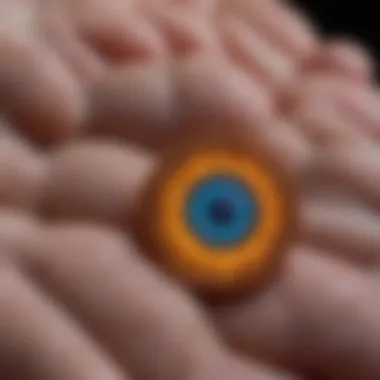Neurofibroma Mitosis: Insights and Implications


Intro
Neurofibromas represent a complex area of study within the fields of oncology and genetics. As benign tumors that primarily arise from Schwann cells, they are often associated with neurofibromatosis, a genetic disorder that impacts the growth of nerve tissue. Understanding how neurofibromas relate to cellular processes, particularly mitosis, provides essential insights into tumor biology. This relationship between neurofibromas and mitosis is crucial not only for understanding tumor growth but also for exploring potential therapeutic avenues.
Background and Context
Overview of the research topic
The intricacies of neurofibromas are closely linked to the mechanisms of mitosis— the process by which a single cell divides to produce two identical daughter cells. Disruptions in mitotic regulation can contribute to tumor formation and growth. Studying these processes helps elucidate the biological basis of neurofibromas and their behavior within the body. Scientists have begun to uncover the genetic and environmental factors that play critical roles in this relationship.
Historical significance
Historically, the study of neurofibromas has highlighted key developments in understanding genetic disorders and cancer biology. Research into neurofibromatosis types 1 and 2 has revealed how mutations in specific genes can lead to tumor formation. Over time, advancements in genetic sequencing and cell biology have allowed for deeper exploration of how mitotic processes affect neurofibroma development and characteristics.
Key Findings and Discussion
Major results of the study
Recent studies have shown that the regulation of the cell cycle is often altered in neurofibromas. Findings include evidence of increased rates of mitotic figures in neurofibroma samples, suggesting that uncontrolled proliferation of Schwann cells may drive tumor growth. Furthermore, genetic anomalies, particularly in the NF1 gene, are frequently implicated in the dysfunctional regulation of mitosis in these tumors.
Detailed analysis of findings
The aberrations in mitotic regulation typically manifest in several ways. These include abnormalities in spindle formation and chromosomal segregation during cell division. Neurofibromas often exhibit an increased number of cells in mitosis under microscopic examination, indicating a potential link to their growth mechanisms. Understanding these relationships can pave the way for targeted therapies that address the underlying molecular pathways involved in mitosis.
Prologue to Neurofibromas
Understanding neurofibromas is essential in the broader context of oncology and genetics. These tumors, primarily associated with the neurofibromatosis disorders, present a unique combination of clinical and biological characteristics that influence their behaviors and treatment pathway. Neurofibromas can manifest in a variety of ways, depending on various factors, including their location, growth patterns, and potential to undergo malignant transformation.
Neurofibromas form from nerve tissue and typically arise in connective tissue cells called Schwann cells. They generally appear as benign growths; however, in certain instances, these tumors can lead to significant health complications for the patient. Therefore, exploring the intricacies of neurofibromas helps illuminate the mechanisms that drive tumor development and growth. This understanding can significantly impact future therapeutic approaches.
Definition and Characteristics
Neurofibromas are benign tumors that originate from Schwann cells, a type of glial cell that supports nerve fibers. These tumors are characterized by their soft, fleshy texture, and they can occur in various forms, including cutaneous, subcutaneous, and plexiform neurofibromas.
Cutaneous neurofibromas typically arise on the skin's surface, affecting appearance but rarely causing severe complications. In contrast, plexiform neurofibromas can infiltrate the surrounding tissues, and their potential for malignant transformation makes them more concerning. The presence of multiple neurofibromas is a hallmark of neurofibromatosis type 1.
Epidemiology of Neurofibromas
The prevalence of neurofibromas is notably linked to genetic factors, particularly those affecting Schwann cell development. Neurofibromatosis type 1 affects approximately 1 in 3,000 individuals, with neurofibromas being one of the most common manifestations of the disorder. The disorder does not discriminate by gender or ethnicity, reflecting a widespread genetic influence.
Studies also indicate that the number of neurofibromas can increase with age, often becoming more pronounced during adolescence or early adulthood. Their natural history often includes periods of growth followed by stability; however, their careful monitoring is crucial in clinical practice.
Genetic Basis of Neurofibromas
The genetic foundation of neurofibromas primarily resides within the NF1 gene. Mutations in this gene, located on chromosome 17, disrupt normal cell signaling pathways involved in tumor suppression. The loss of function in this gene leads to increased proliferation of Schwann cells, resulting in neurofibromas.
Research has pointed out that while NF1 mutations are prevalent in neurofibromatosis type 1, other genetic factors may contribute to neurofibroma development in sporadic cases. Understanding these genetic underpinnings is vital, as these insights hold promise for potential targeted therapies in the future.
"The identification of genetic mutations informs not only prognosis but also potential treatment pathways for neurofibromas."
In summary, neurofibromas are significant not just as clinical entities but as drivers of ongoing research in genetics and treatment strategies. By delving into their definitions, epidemiology, and genetic bases, researchers can pave the way for better diagnosis and intervention.
Understanding Mitosis


Understanding mitosis is crucial in the study of neurofibromas, as this process is central to how cells divide and proliferate. The link between cell division and tumor growth cannot be overemphasized. Neurofibromas are tumors that arise from Schwann cells, which are responsible for the myelin sheath surrounding nerves. Any alteration in the normal mitotic cycle can lead to abnormal cell growth, contributing to tumor development. Therefore, a clear grasp of mitosis aids in understanding the pathogenesis of neurofibromas and may reveal potential areas for therapeutic intervention.
The Cell Cycle Overview
The cell cycle consists of several phases that lead to cell division. It can be broadly divided into interphase and mitotic phase. Interphase includes G1 (cell growth), S (DNA synthesis), and G2 (preparation for mitosis) phases. Each phase is essential in ensuring cells are ready for division. Mitosis, which encompasses the processes of prophase, metaphase, anaphase, and telophase, follows interphase. Understanding this cycle helps elucidate how neurofibromas can alter normal cellular behavior.
Phases of Mitosis
Prophase
Prophase marks the beginning of mitosis. During this phase, chromatin condenses to form visible chromosomes, and each consists of two sister chromatids. The nuclear envelope starts to break down, and the mitotic spindle begins to form. This phase is significant because it prepares the genetic material for equal distribution between the two daughter cells. A key characteristic of prophase is its role in initiating the cell division process, making it a vital step in understanding mitotic regulation in neurofibromes. However, it is also a phase where defects can lead to uneven chromosome distribution, a concerning outcome in tumor development.
Metaphase
Metaphase is characterized by the alignment of chromosomes along the metaphase plate. This positioning is crucial for the subsequent separation of sister chromatids. The attachment of spindle fibers to the kinetochores ensures that each chromatid will move to opposite poles. This phase is critical as it ensures accuracy in chromosome distribution. Unique to metaphase is the checkpoint that assesses whether the chromosomes are properly aligned. Any faults here could also have severe implications for tumorigenesis in neurofibromas, highlighting its significance in this article.
Anaphase
In anaphase, the sister chromatids separate and move toward opposite poles of the cell. This process ensures that each new cell will inherit an identical set of chromosomes. It is a dynamic phase where the integrity of the process is key to preventing genomic instability. A hallmark of anaphase is the need for proper signaling and mechanical actions to ensure the equal distribution of genetic material. Analysing this phase sheds light on potential misregulation within neurofibromas that contributes to their growth.
Telophase
Telophase marks the final stage of mitosis. Chromatids reach the poles of the cell, and the nuclear envelope reforms around each set of chromosomes. The chromosomes then decondense back to chromatin. This phase concludes mitosis and prepares the cells for cytokinesis, the final split into two daughter cells. Telophase is crucial because the resetting of the nuclear envelope is a critical preparation for establishing two new cells. Understanding telophase helps in comprehending how neurofibromas complete their cell cycle and increase in number, which is important for potential treatment strategies.
Regulation of Mitosis
Regulation of mitosis is a tightly controlled process involving a variety of proteins and checkpoints that ensure cell division occurs correctly. Cyclins and cyclin-dependent kinases are major players in this regulation. Disruptions in these regulatory mechanisms can lead to uncontrolled cell growth seen in tumors like neurofibromas. Insights into this regulation can provide pathways to therapeutic interventions aimed at correcting these process errors.
Understanding the regulation of mitosis is essential to grasp how tumors like neurofibromas might behave differently from normal cells, leading to potential therapeutic breakthroughs.
Biological Mechanisms in Neurofibromas
Understanding the biological mechanisms in neurofibromas is crucial to deciphering the complexities of these tumors. Neurofibromas arise from the proliferation of Schwann cells, which are essential in nerve function and protection. These mechanisms involve a range of cellular activities, including growth regulation, differentiation, and apoptosis, all of which are pivotal in tumor formation and development.
The significance of studying these mechanisms lies in the potential to identify therapeutic targets. As researchers gain insights into the molecular pathways involved in neurofibroma development, it becomes possible to design strategies aimed at interfering with these pathways. This focus not only enhances comprehension of the disease but also informs future treatment options.
Another important aspect centers on the interaction of neurofibromas with their microenvironment. The tumor microenvironment can influence cellular behavior and tumor progression, creating a dynamic interplay that merits thorough investigation. By appreciating these biological interconnections, it is possible to develop holistic approaches to treatment that consider both the tumor cells and their surrounding cellular milieu.
Cellular Origin of Neurofibromas
Neurofibromas typically originate from Schwann cells. These glial cells are integral to the nervous system, providing insulation to axons. In conditions such as neurofibromatosis type 1, mutations in the NF1 gene lead Schwann cells to divide uncontrollably, producing neurofibromas.
Research indicates that both genetic and environmental factors contribute to the emergence of these tumors. Notably, Schwann cells possess a remarkable capability for regeneration, which may also play a role in tumorigenicity. The study of the cellular origin of neurofibromas can illuminate understanding of broader neurofibromatosis disorders, which can ultimately impact clinical approaches.
Key Points:
- Originates from Schwann cells, essential in peripheral nerve function.
- NF1 gene mutations are a major contributor.
- Environmental factors may also play a role in tumor development.
Mitosis in Tumor Growth
Mitosis is a fundamental process in cell division that directly influences tumor growth. In neurofibromas, the regulation of mitotic processes can become altered, paving the way for uncontrolled tumor expansion. Changes in cell cycle checkpoints can lead to excessive proliferation.
Moreover, abnormalities in mitotic spindle formation and chromosome segregation are frequently observed in tumors, including neurofibromas. These defects contribute to aneuploidy, a condition where cells have an abnormal number of chromosomes, which can enhance tumor aggressiveness and complicate treatment.


"The regulation of mitosis is crucial for maintaining cellular integrity; aberrations in this process can have severe implications for tumor biology."
Thus, understanding the role of mitosis in neurofibroma growth extends beyond mere cellular mechanics. It intersects with genetic predispositions and environmental factors that collectively shape tumor behavior.
Implications of Mitosis on Treatment:
- Targeting cell cycle regulators may improve therapeutic outcomes.
- Monitoring mitotic abnormalities could serve as a predictor for aggressive tumor behavior.
- Personalized treatments can be devised based on an individual’s mitotic profile.
Impact of Mitosis on Neurofibroma Development
The role of mitosis in neurofibroma development is a crucial aspect to understand the progression of these tumors. Neurofibromas arise predominantly within the context of neurofibromatosis, a group of genetic disorders. The disturbances in mitotic processes can result in abnormal cellular proliferation, affecting not just tumor growth but also its behavior. This section delves into the implications of such altered processes.
Altered Mitotic Processes in Neurofibromas
Neurofibromas exhibit distinct variations in their mitotic activity. Studies show that the typical patterns of mitosis are disrupted. This dysfunction contributes to the characteristic features seen in these tumors, such as increased size and complex cellular arrangements. Additionally, the alteration in mitotic processes can lead to an imbalance in cell populations, fostering a microenvironment conducive to tumor expansion.
For instance, the mechanisms that usually control the cell cycle may become less effective due to genetic factors inherent in those predisposed to neurofibromas. Some possible implications include:
- Cell Cycle Regulation: The failure of checkpoint proteins can cause cells to divide inappropriately.
- Increased Growth Rates: Abnormal mitotic processes might lead to faster tumor growth, increasing the chances of complications.
- Resistance to Treatment: Tumors that grow rapidly may develop resistance to conventional therapeutic measures.
Genetic Mutations Affecting Mitosis
Genetic mutations play a significant role in the mitotic abnormalities seen in neurofibromas. Specific mutations related to the NF1 gene disrupt normal cell signaling pathways, impacting the regulation of the cell cycle and promoting the uncontrolled growth observed in these tumors. This genetic oversight can initiate a cascade of events that culminates in tumorigenesis.
Some key points concerning these mutations include:
- NF1 Gene Option: This gene is known for its role in coding for neurofibromin, a protein that helps regulate cell growth. Loss of function in this gene correlates with the formation of neurofibromas.
- Enhanced Division Rates: Mutations may not just affect the NF1 gene but also influence others related to mitosis, resulting in enhanced cellular division rates.
- Potential Targets for Therapy: Identifying specific mutations could pave the way for targeted therapies, addressing the underlying genetic causes of mitotic dysregulation.
Clinical Implications
The clinical implications of understanding neurofibromas in the context of mitosis are profound for both diagnosis and treatment. A detailed comprehension of these elements can significantly impact patient outcomes in neurofibromatosis disorders. Neurofibromas themselves are not just benign growths; they represent critical manifestations that require thorough evaluation. The focus here is on how insights into mitotic processes influence clinical practice.
Diagnosis of Neurofibromas
Diagnosing neurofibromas involves a combination of clinical evaluation, imaging studies, and genetic testing. Physicians often rely on physical examinations and patient history to identify symptoms typical of neurofibromatosis. Palpable tumors are usually the first indicators, but imaging techniques such as MRI play a pivotal role in forming a clearer picture of tumor spread and location.
- Importance of Imaging: MRI is used to assess the extent of lesions and to differentiate neurofibromas from other tumors. This aids in planning any necessary surgical interventions effectively.
- Role of Genetic Testing: Genetic screening can verify if a patient carries mutations in the NF1 gene, which is crucial for accurate diagnosis. Early detection of genetic predisposition allows for more tailored patient monitoring.
Treatment Options and Challenges
Treatment decisions for neurofibromas often come with various challenges. The approach varies based on symptoms, tumor size, and patient health status.
- Surgical Removal: Surgical excision is common for symptomatic neurofibromas. However, incomplete removal may lead to recurrence. Moreover, the surgical landscape is complicated because of the delicate nature of surrounding neural structures.
- Observation: In certain cases, especially in asymptomatic patients, a watchful waiting strategy is adopted. Monitoring growth is essential to avoid unnecessary interventions.
- Innovative Therapies: Emerging therapeutic approaches, including targeted therapies that focus on the molecular underpinnings of neurofibromas, are currently being explored. These may offer less invasive options than traditional surgery, but they also present the challenge of understanding the efficacy and safety of these treatments in a diverse patient population.
Understanding the clinical implications and treatment challenges of neurofibromas paves the way for improved patient management strategies.
The complex interplay between neurofibroma development and mitotic regulation indicates a pressing need for advancing research and refining clinical practices. As more insights emerge from ongoing studies, it is crucial for clinicians to stay informed about the latest developments to ensure they provide optimal care.
Current Research Trends
Research into neurofibromas and their link to mitotic processes is crucial in understanding the underlying biological dynamics of these tumors. Neurofibromas are complex entities that arise predominantly in individuals with neurofibromatosis. The rapid advances in molecular biology and genetics offer new insights that can greatly influence therapeutic strategies.
Molecular Studies on Neurofibromas


Current molecular studies on neurofibromas focus on the genetic mutations and signaling pathways involved in their development. Researchers are particularly interested in the NF1 gene, which, when mutated, contributes to the growth of these tumors. Studies have demonstrated that this gene's dysregulation can lead to altered mitotic processes, promoting uncontrolled cell division.
Furthermore, techniques such as next-generation sequencing are employed to understand the mutational landscape of neurofibromas. These studies aim to identify additional mutations that might contribute to tumor behavior. By understanding how mitotic regulation is affected, researchers can delineate potential targets for intervention. This not only enriches the current knowledge base but also lays groundwork for future studies in targeted therapies.
Innovative Therapeutic Approaches
The quest for effective therapeutic approaches for neurofibromas is gaining momentum. Several innovative strategies are being explored, such as targeted therapies and immunotherapies.
- Targeted Therapies: Medications that specifically target genetic mutations related to neurofibromas are under investigation. For example, selumetinib, a MEK inhibitor, has shown promise in reducing the tumor burden in patients with symptomatic neurofibromas.
- Immunotherapy: This strategy harnesses the body’s immune system to combat tumors. Early-stage trials are evaluating the effectiveness of checkpoint inhibitors and other immunomodulating agents.
- Combination Therapies: Combining conventional therapies with novel agents can provide synergistic effects. Researchers are exploring the use of chemotherapeutic agents alongside targeted therapies to enhance treatment efficacy.
“Understanding the molecular basis of neurofibromas is essential for developing effective therapies.”
For further reading on neurofibromas and related research, you may refer to Wikipedia or Britannica.
Future Directions in Research
The exploration of neurofibromas in relation to mitosis presents numerous avenues for future research. Understanding the nuances of how mitotic processes contribute to neurofibroma pathogenesis is essential. This knowledge could unearth potential targets for therapeutic interventions. Altogether, research efforts in this area could lead to significant advancements in the clinical management of these tumors.
Understanding Mitosis in Neurofibromas
Research in this area should focus on the specific mitotic dysregulations observable in neurofibromas. This may involve analyzing the cell division mechanics unique to these tumors. Previous studies show that neurofibromas often harbor mutations that affect key mitotic regulators such as p53 and Rb. By thoroughly examining these pathways, researchers can chart how abnormal mitosis fosters tumor proliferation. This includes exploring mitotic checkpoints and the roles of microtubules in the cell division process. Gaining deeper insights into these cellular phenomena helps in elucidating how neurofibromas differ biologically from other tumor types.
Furthermore, high-resolution imaging techniques may provide valuable perspectives. Using live-cell imaging to observe mitotic behavior in real-time can reveal how neurofibroma cells deviate from normal mitotic processes. This could provide a clearer picture of the cellular biology driving tumor growth and survival.
Potential for Personalized Medicine
The future of treating neurofibromas may hinge on personalized medicine strategies. As research progresses, the identification of specific genetic mutations linked to neurofibromas may enable tailored therapies. Understanding an individual's unique genetic make-up can pave the way for bespoke treatment plans, maximizing efficacy while minimizing adverse effects.
Additionally, the integration of genomic profiling into clinical practice is paramount. Tests that evaluate the expression levels of genes associated with mitotic regulation could aid in predicting tumor behavior. This stratification of patients based on molecular characteristics can optimize therapeutic outcomes. For instance, patients with specific mutations might benefit from targeted drugs that inhibit aberrant mitotic pathways.
The implementation of personalized approaches requires significant collaboration across multiple disciplines, including genetics, oncology, and bioinformatics. Ongoing studies should focus on establishing databases that correlate genetic markers with clinical outcomes, guiding clinicians in their treatment choices.
Understanding the relationship between shared genetic mutatons and personal treatment strategies will drive innovation in neurofibroma therapies.
In summary, the future research directions in neurofibromas and mitosis hold great potential. By diving deeper into mitotic intricacies and embracing personalized medicine, the medical community may ultimately enhance the prognosis for patients with neurofibromas.
Ending
The conclusion of this article serves as a pivotal reflection on the intricate relationship between neurofibromas and mitotic processes. Within the vast expanse of cancer research, understanding mitosis in relation to neurofibromas offers significant insights into tumor biology and treatment strategies.
Key components highlighted include how altered mitotic processes contribute to neurofibroma development. Analyzing this dynamic opens pathways for potential therapeutic interventions. Furthermore, recognizing genetic mutations that influence mitotic regulation sheds light on the mechanisms driving tumor growth, which is integral for addressing clinical outcomes.
By synthesizing findings, it is important to note that the implications extend beyond understanding neurofibromas alone. The broader context of cancer research is enhanced by these insights, promoting the potential for personalized treatments and improved prognosis for patients. Researchers must continue to explore these links to develop effective strategies for managing neurofibromas and potentially other related tumors.
Summary of Key Findings
The research dissected in this article elucidates several key findings:
- Mitosis and Tumor Growth: Alterations in mitotic regulation significantly affect neurofibroma proliferation.
- Genetic Factors: Specific genetic mutations have been identified that can disrupt normal mitotic processes in neurofibromas.
- Clinical Insights: Understanding these factors provides a foundation for innovative treatment approaches tailored to the biological behavior of neurofibromas.
These elements emphasize the complexity of neurofibromas and underscore the critical need for ongoing research in this area.
Significance in the Context of Cancer Research
The significance of this topic in cancer research is manifold:
- Understanding Tumor Dynamics: Dissecting the relationship between neurofibromas and mitosis enhances overall comprehension of tumor growth and behavior.
- Impacts on Treatment: Clinical strategies can improve by considering mitotic regulation, potentially leading to more targeted therapies.
- Broader Applications: Insights from neurofibromas could inform research on other tumors, leading to a richer understanding of oncogenesis.
In summary, the exploration of neurofibroma mitosis is crucial in advancing cancer research. It contributes substantially to our understanding of tumor biology and presents opportunities for innovative approaches to treatment.







